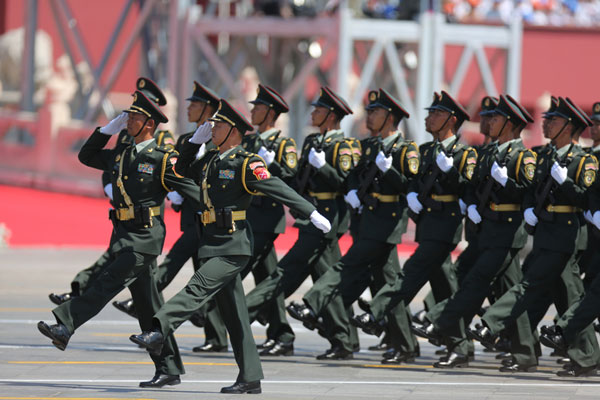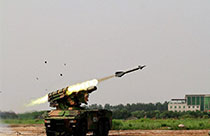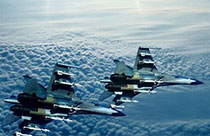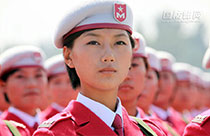


2015-09-03 is a red letter day in the history of China and indeed the region and the world, because on this day, China displayed one of the most inspiring military parades in modern history-commemorating the 70th Anniversary of the defeat of fascist forces in one of the longest struggles against imperialism-the day World War II came to a formal end when the Japanese forces were vanquished and signed the instrument of surrender.
China has been celebrating the memorable event the whole year dedicated to various events commemorating the 70th anniversary, paying homage to the surviving veterans and cherishing the memories of those brave Chinese who sacrificed their lives as well as honour those foreigners who supported China in its struggle to break away from the chains of tyrannical Japanese occupation.
April 5 is observed as "Tomb Sweeping Day" every year as people across China pay respect to the soldiers and civilians who lost their lives in the war. It's a great tradition to honour the dead and pay homage to the ancestors by visiting the tombs and memorials commemorating the sacrifice of the Chinese in liberating their nation but this year it had a special meaning. Earlier, the Railway Guerrilla memorial in Shandong Province was visited by thousands of students. During the Anti-Japanese War, railway guerrillas in Shandong Province led by the CPC attacked the enemy on trains and blasted bridges.
A heritage park honoring the Flying Tigers was inaugurated in South China's Guilin City. The Flying Tigers, officially known as the American Volunteer Group of the Chinese Air Force, were formed in 1941, led by U.S. General Claire Lee Chennault to help China drive out invading Japanese troops.
On September 2, 2015, the eve of the high-profile V-Day celebrations, President Xi Jinping awarded medals to 30 Chinese and foreign veterans and civilians who fought for China in World War II.
Among those honored with medals were Anna Chan Chennault, wife of American pilot Claire Chennault, mentioned earlier, Joseph W. Stilwell, grandson of Joseph Stilwell, commander of China-Burma-India Theater, and M. W. Bethune, the grandson of Norman Bethune, a famous Canadian army surgeon in China, who saved thousands of lives with his surgical skills even to the peril of his own life. A female medical soldiers' formation at the parade was named after Norman Bethune to honor his contribution to Chinese people's fight against Japanese aggressors.
China's central government decided to grant such medals to roughly 210,000 veterans or relatives. The front of the medal is embossed with WWII soldiers, a pagoda from a revolutionary base in Yan'an, the Yellow River, and an olive branch. It symbolizes CPC's decisive role during the war, China's drive for rejuvenation and its aspirations for world peace.
Symbolism, which plays an important role in Chinese culture, was evident throughout the mega event. The parade lasted for seventy minutes; military aircraft flew in formations depicting seventy while 70,000 white doves symbolizing peace and 70,000 multicoloured balloons were released to mark the end of the ceremony. The white doves accentuated President Xi Jinping's message while announcing the massive cut of 300,000 troops in the Peoples Liberation Army, stating that China was committed to peaceful development. He solemnly pledged that his country would "never seek hegemony or expansion. It will never inflict its past suffering on any other nation". His resounding words reiterated: "Let us bear in mind the great truth of history: Justice will prevail! Peace will prevail! The people will prevail!"
Unfortunately, the strong message was lost on the Doubting Thomases, who chose to stay away from an event that was more for healing wounds rather than raking them. The Occident, which is propagating that the parade was an indication of China flexing its muscles, remain oblivious of the fact that Japan is pursuing to amend its constitution to build its armed forces again, which may actually endanger the region and the world.
Japanese Prime Minister Shinzo Abe, who was extended an invitation to participate, not only spurned the gesture but was critical of the attendance by UN Secretary General Ban Ki Moon. Japan could have taken a leaf out of the book of its WW II ally Germany, whose leaders attend V-Day events in France repeatedly.
In fact Abe missed a great opportunity to provide closure to the subject, where he could have attended the proceedings and sought forgiveness from not only the Chinese but its other neighbours, whom it had conquered, raped and massacred.
On the contrary, Li Keqiang Premier of China and Park Geun-hye President of the Republic of Korea, both victims of Japan's atrocities, in a gesture to bury the hatchet, expressed common interest in seeking cooperation with Japan. The ball is again in Shinzo Abe's court to respond altruistically or otherwise.
The impressive military parade was thoughtfully choreographed. It's been 84 years since China was dragged into war following Japan's invasion of northeast China in 1931. Of the 500 military hardware displayed during the parade, 84% are modern and had heretofore not been displayed by China. The PLA guards of honor and 10 foot formations were each named after a morale-boosting battle fought by Communist-led troops or Chinese war heroes and model combatants. Besides the 12,000 Chinese troops who goose-stepped past the Tiananmen Rostrum in 128 carefully measured paces, each precisely 75 cm, 1,000 foreign troops from 17 countries also marched in step, drawing applause from the spectators.
The message that came out loud and clear from the awe-inspiring military parade is that China and its people cherish and love peace but to safeguard that peace, they are willing to build deterrents since weakness invites aggression. A signatory of the Treaty on the Non-Proliferation of Nuclear Weapons, China has repeatedly vowed to adhere to the policy of no-first-use of nuclear weapons and the policy that it will, unconditionally, not use or threaten to use nuclear weapons against non-nuclear-weapon states and nuclear-weapon-free zones.
China's latest white paper on military strategy issued this year underscored its principles of "defense, self-defense and post-emptive strikes." Bravo China!
(The author is a retired PAF Group Captain and a TV talk show host based in Pakistan.)
 'Enemy planes' intercepted by Hongqi-7B air-defense missiles
'Enemy planes' intercepted by Hongqi-7B air-defense missiles Blind date with bikini girls in Nanjing
Blind date with bikini girls in Nanjing Amazing photos of Chinese fighter jets
Amazing photos of Chinese fighter jets Chinese soldiers participate in training for V-Day parade
Chinese soldiers participate in training for V-Day parade Painting: Lonely women in Forbidden City
Painting: Lonely women in Forbidden City China and Russia hold joint drill in Sea of Japan
China and Russia hold joint drill in Sea of Japan 'Goddess' in Taiwan McDonald's
'Goddess' in Taiwan McDonald's Female soldiers at military parades
Female soldiers at military parades Photos of campus belle doing splits go viral
Photos of campus belle doing splits go viral Dietary deceptions
Dietary deceptions China to optimize forces
China to optimize forces US Treasury sale a ‘normal’ option: experts
US Treasury sale a ‘normal’ option: experts Parade, military cut send explicit message
Parade, military cut send explicit messageDay|Week